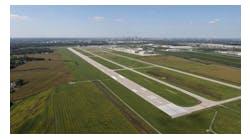PHL Celebrates the Construction of Aircraft Parking Apron
Representatives from the city of Philadelphia’s Division of Aviation and elected officials celebrated the construction of Philadelphia International Airport’s (PHL) new Remain Overnight (RON) aircraft parking apron at a groundbreaking on July 14. The apron is located on the northwest corner of PHL’s airfield, next to the FedEx facilities in Cargo City and on the former site of the USPS facility that was demolished in 2018. The $40 million project is expected to be completed in June 2022.
This RON project serves two functions for our airport,” said PHL CEO Chellie Cameron. “First, by providing aircraft parking space away from terminal gates, our airline partners can perform their terminal operations more efficiently. Second, as PHL begins its West Cargo Development program, the location of the apron provides quick access to cargo facilities and our runways.”
PHL received a $2 million Pennsylvania Redevelopment Assistance Capital Program (RACP) grant for the RON apron. This state grant program is administered by the Office of the Budget for the acquisition and construction of regional economic, cultural, civic, recreational, and historical improvement projects.
“Thank you to our state elected officials for recognizing the importance of our aircraft parking project and awarding PHL an RACP grant,” said Cameron. “As we work to grow our passenger and cargo operations, having an amenity like this parking apron will make PHL more attractive to current and prospective partners.”
“I’m very excited to support the airport’s project, which will improve the efficiency of operations at the terminals and set the stage for a big expansion of cargo activities,” said State Senator Tim Kearney (D-Delaware). “Not only will the RON create great jobs for our construction and building trades, but the ensuing cargo activities will create permanent good jobs for people in Delco and Philadelphia. As an architect, I’m excited by the project’s innovation.”
When finished, the RON apron will accommodate eight aircraft. A portion of the constructed pavement will also be used as parking for deicing trucks. The project incorporates ultra-lightweight foam glass aggregate in the construction of the embankment for the apron. The use of this material is intended to mitigate the expected consolidation of the underlying soils at the site, typically experienced from the additional weight of the pavement structure and fill material used to construct the apron. The use of this material at PHL is a first and was chosen to minimize the construction time for the project. Typical construction methods used to address consolidation of soils would add a minimum of 6 months to the construction schedule.



